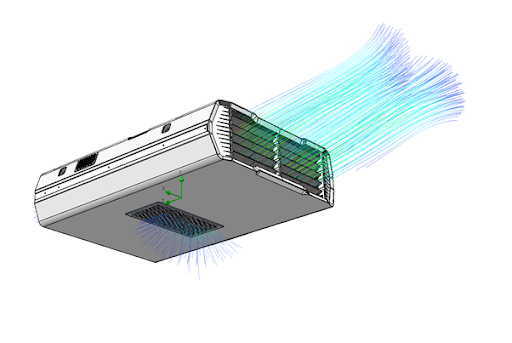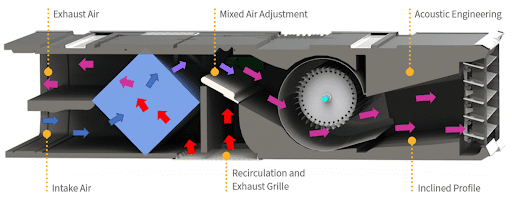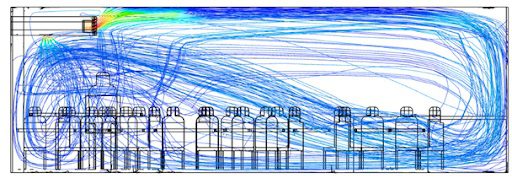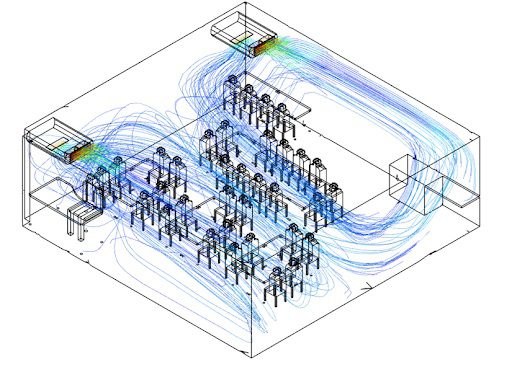Monodraught is unique in the sense that they are both manufacturers and consultants. They develop high-performing, low-energy building products and provide design services for engineering a sustainable built environment. They not only design ventilation, cooling, and heating systems but they also install and maintain these systems for healthier occupants in public buildings including schools and educational institutions, healthcare facilities, retail spaces, and offices.
Monodraught specializes in sustainable and low energy/carbon products to meet the growing demand of the net-zero policies in the UK and abroad. As such, they critically value R&D to continuously bring new products to a rapidly changing and growing market.
Net Zero Hybrid Ventilation Systems
Beginning last year, Monodraught began developing a product that integrates ventilation, cooling, and intelligent control strategies and would set a new benchmark for the future generation of low-energy hybrid ventilation and cooling systems. They quickly realized that to create a brand new, top-of-the-line product their design process had to be CFD-led.
The HVR Zero provides natural ventilation, hybrid mixing ventilation, and low-energy mechanical heat recovery ventilation in one compact unit. Naturally, the use of computer-aided engineering (CAE) would be required as the behavior of airflow is critical to its design. HVR Zero uses fans to drive airflow, with a mix of air intakes/exhausts and recirculation. CFD would be a critical tool in development for two reasons; 1) to optimize the flow path and minimize pressure losses and 2) to calculate heat exchange efficiency, as the HVR Zero design contained a heat recovery element. Ultimately, CFD would be driving the iterative process to achieve a product design that radically reduces energy use in operation. The results of each simulation are used to alter the design and re-simulate and, using this cycle, Monodraught is able to converge on an optimal design for the HVR Zero.
CFD Simulation in the Cloud
Monodraught’s design team is comprised of engineers who possess a mix of skills including product and industrial design, mechanical engineering, electronics, and advanced CAD users. Before using SimScale, the team worked with desktop software that did not offer collaboration features, nor the accessibility and performance of cloud computing. The desktop software was also lacking the live tech support that Monodraught wanted to ensure simulations ran in a timely manner to meet their deadlines.
As a cloud-native solution with in-product sharing and support, SimScale was a strong fit for the team’s needs. Monodraught product designers, who use Solidworks for the 3D modeling of new products, could easily import their Solidworks files (or other CAD types) and begin simulating right away.
The team ran simulations to achieve two different objectives when designing the HVR Zero:
CFD for Product Optimization
The first use of CFD was modeling the product itself which is designed to provide the lowest overall yearly energy use. The CFD-optimized air paths increased ventilation flow rates and reduced fan power consumption by over 50% compared to previous models.
There were several key product features where CFD analysis was critical:
- Heat exchanger – Low-pressure heat exchanger with wide fin spacing to prevent obstruction.
- Digital brushless fan – High-performance digital fan reduces power consumption and improves flow rates.
- Intake and exhaust – Horizontally split intake and exhaust paths match louvre configuration, improving airflows
- Inclined profile – Maximizes air velocities aligning airflow against profiled surfaces.
- Mixed air adjustments – Insulated internal dampers control airflows selecting ventilation methods dependent on internal sensors.
CFD for Compliance and Customer Value
The second use of CFD allowed Monodraught to assess ventilation and thermal comfort in a room to understand how the product performed, as installed. These simulation results were used to show customers that the HVR Zero can meet strict thermal comfort and fresh air requirements that are a part of building regulations. Having access to strong visuals from SimScale showing the air mixing in the room and comfort metrics such as predicted mean vote (PMV) and predicted percentage of dissatisfied (PPD) has been important for Monodraught when articulating the value of their products to customers.
Another of Monodraught’s aims with simulation was to prove system compliance with BB101 (ventilation in schools) and ISO-7730 in a standard classroom environment.
Using SimScale, they were able to quickly set up a steady-state incompressible simulation with convective heat transfer applying the K-Omega SST (w/ wall functions) turbulence model. They created a Hex-dominant mesh with over 20 million cells and five boundary layers, with a growth rate of 1.5 and overall relative thickness of 0.4 for the walls. The average run-time for each detailed simulation was 4-6 hours. Because of the parallel simulation capabilities in SimScale, they were able to run multiple simulations simultaneously, saving valuable time. These simulations yielded results that demonstrated compliance with the criterion set by the BB101 standard.
Monodraught & SimScale: CFD-Led Design
The ease of using SimScale has now established a CFD-led design approach on all of Monodraught’s products moving forward. Their engineers can collaborate with each other using the cloud features and SimScale’s in-product support has been instrumental in enabling Monodraught to meet strict deadlines at a high standard. Because of Monodraught’s multidisciplinary skills in-house they have a reputation for solving complex design problems. With the recent COVID-19 pandemic and ensuing lockdown measures, Monodraught has been providing product and thought leadership expertise on how best to ventilate indoor spaces that are critical to the functioning of society, including schools and hospitals. They now consider their analysis and simulation capabilities, powered by SimScale, to be one of their core strengths.
To learn more, watch our on-demand webinar where Technical Director at Monodraught Ltd. Nick Hopper showcases how CFD is used in the design of low-energy hybrid ventilation and cooling systems that integrate intelligent control strategies and reduce energy demand by 90%.
If you’d like to see how cloud-based simulation can optimize your HVAC product design process, check out our additional resources below:
- Designing Passivhaus Buildings with CFD
- Thermal Environment and Indoor Air: Guide for Building Designers
- Improving the Performance of HVAC Systems with CAE







